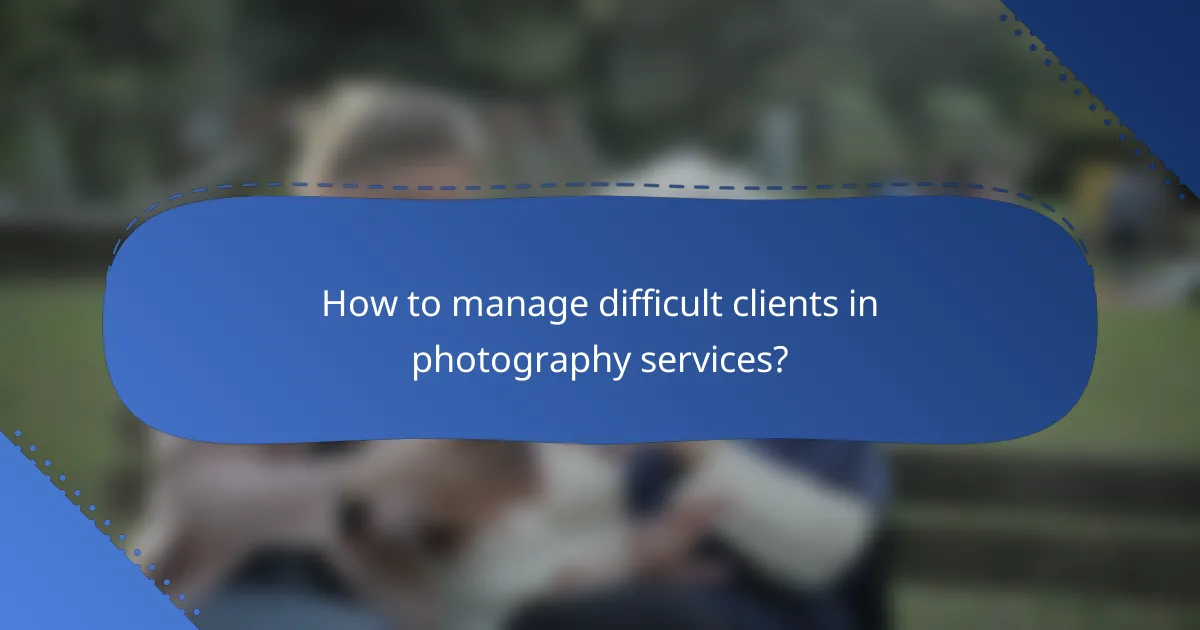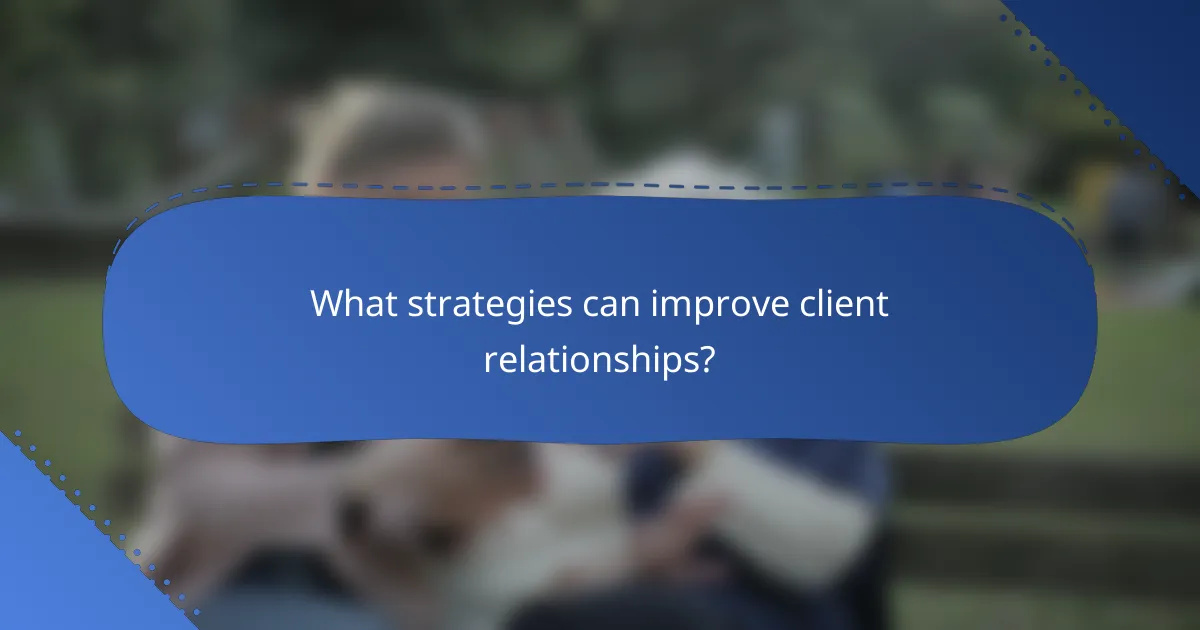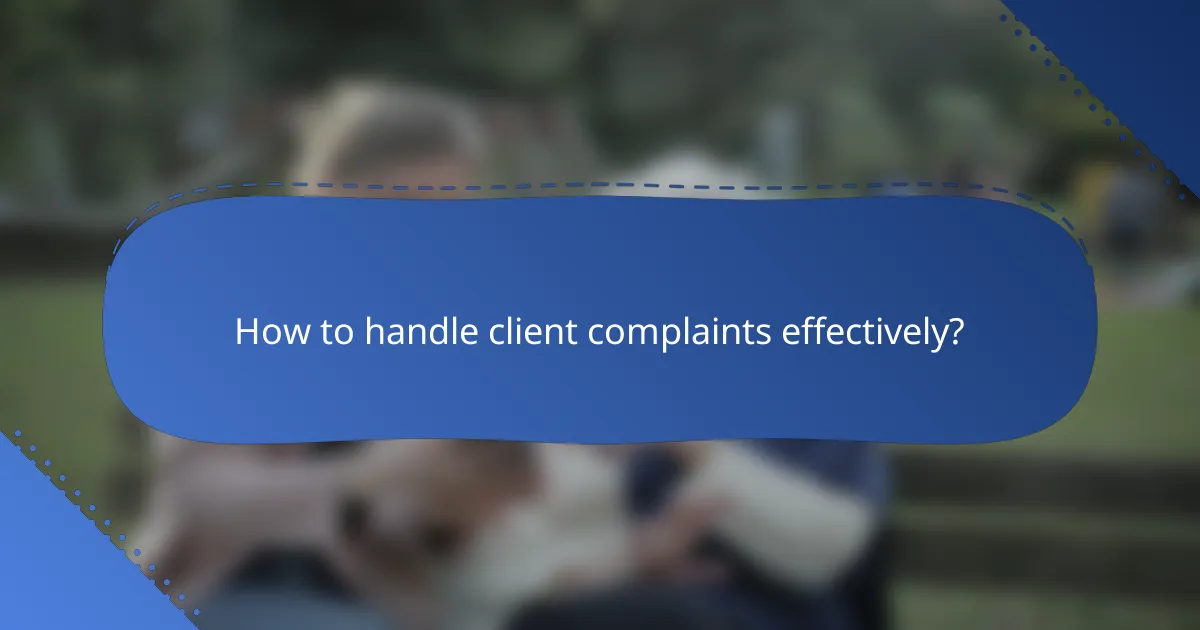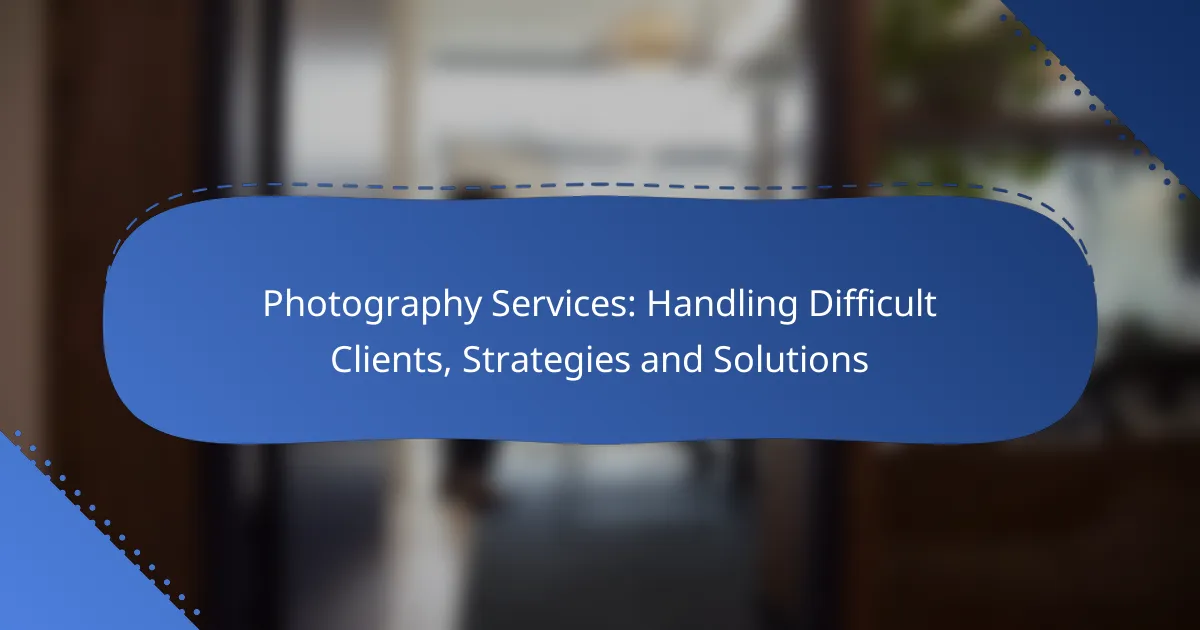In the world of photography services, managing difficult clients requires a blend of clear communication and proactive strategies. By setting expectations and addressing concerns promptly, photographers can transform challenging interactions into opportunities for building stronger relationships. Employing effective conflict resolution techniques not only enhances client satisfaction but also fosters loyalty and trust.

How to manage difficult clients in photography services?
Managing difficult clients in photography services involves clear communication, setting expectations, and employing effective conflict resolution strategies. By understanding client needs and addressing concerns proactively, photographers can foster a more positive working relationship.
Clear communication strategies
Clear communication is essential when dealing with challenging clients. Use straightforward language and avoid jargon to ensure that clients understand your services and processes. Regular updates about project progress can also help mitigate misunderstandings.
Utilize various communication channels, such as email, phone calls, or messaging apps, to accommodate client preferences. This flexibility can enhance rapport and make clients feel more involved in the process.
Setting expectations
Setting clear expectations from the start can prevent many issues with difficult clients. Discuss project timelines, deliverables, and pricing upfront to ensure everyone is on the same page. A written contract detailing these aspects can serve as a reference point throughout the project.
Be transparent about what clients can expect in terms of photo quality, editing styles, and turnaround times. This clarity helps clients understand your creative process and reduces the likelihood of dissatisfaction.
Active listening techniques
Active listening is crucial when managing difficult clients. Show genuine interest in their concerns by maintaining eye contact, nodding, and summarizing their points to confirm understanding. This approach demonstrates that you value their input and are committed to addressing their needs.
Encourage clients to express their thoughts and feelings openly. By creating a safe space for dialogue, you can uncover underlying issues and work collaboratively towards solutions.
Conflict resolution methods
When conflicts arise, address them promptly and professionally. Acknowledge the client’s feelings and validate their concerns before proposing solutions. This approach can help de-escalate tensions and foster a more cooperative atmosphere.
Consider offering compromises, such as additional edits or a discount on future services, to resolve disputes amicably. Document any agreements made during these discussions to ensure clarity and accountability moving forward.

What strategies can improve client relationships?
Improving client relationships in photography services involves personalized attention, consistent communication, and effective feedback mechanisms. These strategies help in understanding client needs, addressing concerns promptly, and fostering a positive experience.
Personalized service approaches
Personalized service approaches are essential for building strong client relationships. Tailoring your services to meet individual client preferences can significantly enhance satisfaction. For instance, remembering specific details about a client’s previous projects or preferences can create a more personalized experience.
Consider offering customized packages that align with the client’s vision, such as themed shoots or unique editing styles. This not only demonstrates your commitment but also encourages clients to feel valued and understood.
Regular follow-ups
Regular follow-ups are crucial in maintaining client relationships after the initial engagement. Scheduling check-ins, whether through emails or phone calls, can help address any lingering questions or concerns. Aim to follow up within a week after delivering the final product to ensure client satisfaction.
Additionally, setting reminders for periodic follow-ups, such as around anniversaries or special occasions, can keep your services top-of-mind for clients. This proactive approach can lead to repeat business and referrals.
Feedback collection systems
Implementing feedback collection systems allows you to gather insights directly from clients about their experiences. This can be done through surveys or informal conversations post-shoot. Aim for concise questions that focus on key aspects of your service, such as communication, quality, and overall satisfaction.
Using feedback effectively means not only collecting it but also acting on it. Regularly review feedback to identify trends and areas for improvement. This demonstrates to clients that you value their opinions and are committed to enhancing your services.

How to handle client complaints effectively?
Handling client complaints effectively involves prompt communication, active listening, and providing practical solutions. Addressing issues quickly can turn a negative experience into a positive one, fostering client loyalty.
Prompt response protocols
Establishing prompt response protocols is crucial for managing client complaints. Aim to acknowledge complaints within a few hours, ideally the same day, to show clients that their concerns are taken seriously.
Utilize a structured system for tracking complaints and responses. This could be a simple spreadsheet or a dedicated customer relationship management (CRM) tool. Regularly review these logs to identify recurring issues and improve service.
Empathy in communication
Empathy is vital when communicating with clients who have complaints. Begin conversations by validating their feelings and expressing understanding. Phrases like “I understand how frustrating this must be” can help diffuse tension.
Active listening is key; allow clients to express their concerns fully without interruption. This not only shows respect but also provides you with valuable insights into their needs and expectations.
Offering solutions
When offering solutions, focus on practical and actionable options that address the client’s specific complaint. This could involve providing a refund, rescheduling a session, or offering additional services at no cost.
Be clear about what you can do and set realistic expectations. If a solution requires time, communicate timelines and follow up to ensure the client feels valued throughout the process.

What are the best practices for client onboarding?
Effective client onboarding is essential for establishing a positive working relationship and ensuring clear expectations. Best practices include detailed contracts, pre-shoot consultations, and portfolio presentations to align visions and avoid misunderstandings.
Detailed contracts
Creating a detailed contract is crucial for protecting both the photographer and the client. It should outline the scope of work, payment terms, cancellation policies, and usage rights for the images. Clear contracts help prevent disputes and ensure that both parties have a mutual understanding of the project.
Consider including clauses that specify deadlines, deliverables, and any additional fees for extra services. This transparency can help manage client expectations and reduce potential conflicts.
Pre-shoot consultations
Pre-shoot consultations allow photographers to understand their clients’ needs and preferences better. These meetings can be conducted in person or virtually and should cover the client’s vision, desired style, and any specific requirements for the shoot.
During the consultation, take notes and ask open-ended questions to encourage clients to express their ideas. This engagement not only builds rapport but also helps in crafting a tailored photography experience that aligns with the client’s expectations.
Portfolio presentations
Presenting a well-curated portfolio is an effective way to showcase your style and expertise. Tailor the portfolio to reflect the type of photography the client is interested in, whether it be weddings, portraits, or commercial work. This targeted approach helps clients visualize the potential outcomes of their project.
Consider using digital platforms or printed materials to present your portfolio. Highlighting previous work that aligns with the client’s vision can instill confidence and facilitate a smoother onboarding process.

How to set boundaries with clients?
Setting boundaries with clients is essential for maintaining a professional relationship and ensuring a smooth workflow. Clear limits help prevent misunderstandings and protect your time and resources.
Defining service limits
Defining service limits involves specifying what services you offer and what is excluded. For example, if you provide photography for events, clarify whether editing, prints, or travel expenses are included in the package. This helps clients understand the scope of your work and reduces the likelihood of disputes.
Consider creating a detailed service agreement that outlines these limits. A well-defined contract can serve as a reference point for both you and the client, ensuring everyone is on the same page.
Establishing working hours
Establishing working hours is crucial for managing client expectations. Clearly communicate your availability, including specific days and times when you are reachable. For instance, you might specify that you are available for consultations from 9 AM to 5 PM, Monday to Friday.
Be consistent with your hours and stick to them. If you occasionally need to adjust your schedule, inform clients in advance to avoid confusion. This practice reinforces your professional boundaries and helps clients respect your time.
Communicating policies clearly
Communicating policies clearly is vital for a successful client relationship. Make sure your policies regarding cancellations, rescheduling, and payment terms are easily accessible and understandable. For example, you might state that cancellations require a 48-hour notice and that deposits are non-refundable.
Consider using multiple channels to share your policies, such as your website, email communications, and contracts. This ensures that clients have ample opportunity to review and understand your terms, minimizing potential conflicts down the line.
